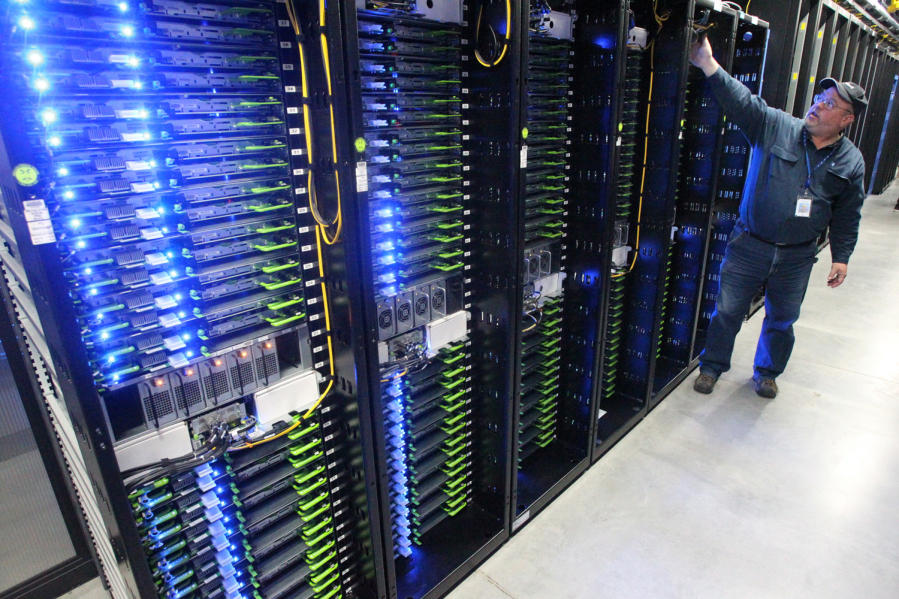PORTLAND — Prineville may lose a factory that could bring more than 300 jobs to the central Oregon community because the region lacks electricity to power the facility, city leaders said.
Facebook and Apple each operate huge data centers on the bluff above Prineville, consuming tremendous volumes of energy. Even so, Prineville says it thought it had lined up plenty of electricity through the Bonneville Power Administration.
When a mysterious manufacturer called “Project Falcon” approached economic development officials last year about building an energy-intensive factory in Prineville, however, Mayor Betty Roppe said the city learned its available power supply won’t meet the company’s substantial electricity needs.
“We just assumed if we had it, we had it,” Roppe told The Oregonian/OregonLive.
Prineville’s power crunch, first reported by The Bulletin newspaper in Bend, illustrates the complexity of managing regional power supplies. It also highlights an unintended side-effect of Oregon’s data center boom.
The massive server farms, lured to the region with large property tax breaks, consume as much electricity as small cities. And while data centers haven’t increased overall power demand nearly as much as regional energy planners once feared, they could create severe constraints in certain parts of the state.
That may limit other kinds of economic growth, like the factory Prineville is courting.
BPA and regional electric utility Pacific Power agree the region generates enough power overall.
The problem is that BPA and Pacific Power lack the transmission capacity to meet industrial demand in Prineville — and, somehow, data center construction went on without anyone realizing this. That could divert Project Falcon elsewhere.
“There’s an economic opportunity but suddenly the community is hearing it may not be available because of problems nobody knew about. That’s kind of the worst-case scenario,” said Scott Bolton, Pacific Power’s vice president of external affairs.
The issue dates to 2012. A transformer upgrade at a substation in Crook County was supposed enable 400 to 600 additional megawatts for the region — enough to handle Facebook’s power needs, new demand from Apple and additional economic development.
When PacifiCorp inquired with BPA about actually obtaining 300 megawatts, though — apparently to supply Apple — the utility and city learned the power they anticipated wasn’t available.
According to the federal power agency, equipment retired elsewhere had an unexpected, cascading effect across its system — limiting transmission capacity to Prineville. And the agency said that limitation didn’t become apparent until late last year, when Pacific Power submitted its large power request.
“We need good information to plan for these large loads. They are significantly larger than any loads we’ve ever had to plan for before,” said Crystal Ball, the BPA’s Oregon liaison.
Pacific Power said it’s flummoxed that the agency wasn’t aware Prineville needed more power: “The queue requests are well known and public and available to them,” Bolton said.
He declined to say, though, if BPA was at fault on the Prineville power crunch, acknowledging that it can be difficult to track power demand across the region. Both the utility and the agency said the Prineville issue highlights a need for better communication.
“I am sympathetic to their position because they don’t have perfect insight,” Bolton said.
For now, BPA said it is “fast-tracking” equipment upgrades that could provide up to 300 additional megawatts for Prineville within two years. And in time, Ball said, the agency may consider another transmission line into the region — though that can be a slow and expensive process.
Unknown project
So Prineville’s power crunch could endure for years. As Apple’s data center expands, solar projects near Madras and Bend — and possible solar projects near Prineville — are seeking more transmission capacity to carry the power they generate.
All that leaves everything about Project Falcon up in the air. Roppe, Prineville’s mayor, says she doesn’t know the identity of the company proposing the facility.
“We know it’s something that will bring us 340 jobs,” Roppe said. “We know they’re going to need a lot of water. We know they’re going to need a lot of electricity.”
Prineville, population 9,200, is recovering from the Great Recession and Les Schwab’s decision to move its corporate headquarters to Bend. Crook County unemployment, which peaked near 20 percent in 2009, now stands at about 7 percent.
Still, that’s well above Oregon’s statewide rate of 4.6 percent, and 340 new factory jobs would handily outnumber the 200 who work at Facebook’s Prineville data center. The facility could have a significant impact in the small community.
With the power situation uncertain, officials in Prineville and elsewhere said Falcon is apparently looking at alternatives including Boardman, Klamath Falls, Ontario and Walla Walla. Looking back, Roppe said she shouldn’t have taken energy assurances from 2012 at face value.
“I think it’s my naivete,” she said, “or the city being naive.”



